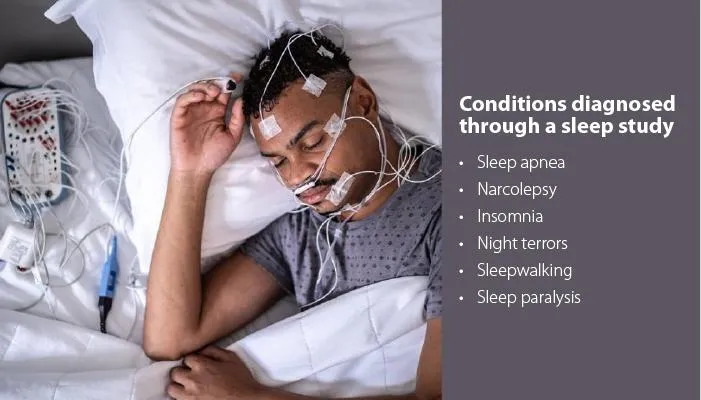Just How a Sleep Research Study Can Change Your Rest Patterns: Insights and Services Available
A rest study acts as an essential device for individuals looking for to understand and improve their sleep patterns. It offers a complete evaluation of sleep behaviors and possible disorders. By examining different metrics, medical care experts can determine underlying issues that interfere with restorative remainder. This procedure not only help in medical diagnosis but likewise sets the phase for tailored therapy plans. What insights might a sleep research reveal concerning your own rest habits?
Comprehending Rest Researches: What to Expect
When individuals get ready for a rest research, they commonly wonder what the experience will certainly involve. These research studies, usually performed in a sleep facility, purpose to monitor different physical parameters throughout sleep. Upon arrival, individuals are greeted by skilled service technicians who assist them through the process. The environment is made to be comfy, allowing for an all-natural rest experience. Individuals might be asked to fill in sets of questions concerning their rest practices and medical history, which aids in the assessment.
As the evening progresses, sensors are connected to the body to track brain waves, heart price, and breathing patterns. While the configuration may really feel unusual, the goal is to gather accurate data on the person's sleep patterns. The entire procedure is non-invasive and positions no threat to the individual. Eventually, the data accumulated during the sleep research study is necessary for detecting potential rest conditions and creating reliable therapy strategies.
Common Rest Disorders Recognized Via Sleep Studies
Rest research studies play an essential duty in determining numerous sleep problems that can significantly affect a person's health and health. Common problems spotted through these researches consist of obstructive sleep apnea, characterized by duplicated disturbances in breathing during sleep, resulting in fragmented rest patterns. An additional common problem is sleeplessness, which entails problem dropping or remaining asleep, commonly leading to daytime fatigue and damaged performance. Uneasy legs syndrome (RLS) is also frequently observed, causing unpleasant sensations in the legs and an unmanageable impulse to relocate them at night. Narcolepsy, a neurological disorder that influences sleep-wake cycles, is an additional major condition recognized in sleep studies, leading to too much daytime drowsiness and sudden sleep attacks. Lastly, parasomnias, which incorporate abnormal behaviors throughout sleep, such as sleepwalking or evening horrors, are additionally kept in mind. Early identification of these problems can facilitate prompt intervention and enhance general rest quality.
The Refine of a Rest Study: From Prep Work to Results
Although the procedure of a sleep research might seem challenging, it is a structured and systematic technique made to collect crucial details concerning a person's rest patterns. A healthcare service provider carries out a detailed evaluation, reviewing sleep background and signs with the client. This evaluation aids establish the details focus of the research.
Prep work normally involves standards on rest hygiene and medicine changes prior to the study. People might be instructed to avoid high levels of caffeine and alcohol to ensure precise results. On the night of the study, electrodes and sensing units are placed to monitor mind activity, heart rate, breathing, and motions throughout sleep.
The information gathered is carefully evaluated by rest specialists, who identify any type of irregularities or patterns indicative of rest disorders. Following this evaluation, a follow-up appointment is set up to review the findings and prospective therapy options tailored to the individual's needs, assisting in better sleep high quality.

Types of Rest Researches: In-Lab vs. Home Sleep Examinations
Two key types of rest studies exist: in-lab researches and home sleep tests, each catering to various demands and situations. In-lab studies usually take place in a sleep center where clients are kept track of over night by medical care experts. This technique enables for comprehensive data collection on numerous rest criteria, such as mind task, oxygen degrees, and heart price. People are commonly linked to numerous sensors, giving thorough understandings into their rest conditions, including rest apnea and narcolepsy.
On the other hand, home sleep examinations offer an easier alternative for individuals that choose to perform evaluations in their very own atmosphere. These mobile gadgets monitor necessary metrics like air movement, oxygen saturation, and snoring. While home tests are much less extensive than in-lab research studies, they act as a sensible service for detecting common sleep problems. Inevitably, the option between these two sorts of rest research studies relies on specific preferences, medical demands, and the seriousness of sleep-related concerns.
Analyzing Your Sleep Research Study Results: Trick Metrics Discussed
Understanding the results of a sleep research study is essential for people looking for insights into their sleep wellness. Trick metrics normally analyzed in sleep research studies include the Apnea-Hypopnea Index (AHI), which gauges the number of apneas and hypopneas per hour of rest. AHI worths aid determine the extent of rest apnea, with greater scores suggesting more substantial concerns. One more important metric is the complete sleep time (TST), which reflects the overall period of sleep during the research. Sleep effectiveness, the ratio of time invested asleep to time invested in bed, is additionally crucial; higher percentages suggest much better sleep top quality. Additionally, the percentage of sleep spent in different phases-- light, deep, and REM-- supplies understandings into sleep architecture. Understanding these metrics equips individuals with the understanding required to discuss their sleep patterns with health care service providers, leading the method for informed decisions about their sleep health.
Therapy Alternatives and Recommendations Based on Your Rest Research study
When a rest research study discloses concerns such as rest apnea or various other sleep conditions, numerous treatment alternatives and suggestions come to be offered to improve overall sleep health and wellness. For obstructive rest apnea, continuous favorable respiratory tract pressure (CPAP) therapy is generally suggested, providing a stable stream of air to maintain air passages open throughout rest. Oral home appliances might be advised for light to moderate cases, repositioning the jaw to avoid airway obstruction.
In cases of sleeplessness, cognitive behavior modification for sleeping disorders (CBT-I) is usually recommended, concentrating on behavior changes and assumed patterns that disrupt sleep. Furthermore, way of living adjustments such as weight loss, regular workout, and staying clear of alcohol or caffeine investigate this site prior to going to bed may enhance sleep high quality.

Building Healthy And Balanced Sleep Habits: Tips for Better Relax
Building healthy and balanced rest behaviors is necessary for achieving restorative rest. Developing a consistent sleep regimen, limiting screen time prior to bed, and developing a comfortable rest atmosphere can considerably boost sleep high quality. These approaches function as fundamental actions for individuals seeking better sleep outcomes.
Develop a Rest Regimen
Developing a consistent rest regimen is crucial for promoting healthy rest practices and improving overall well-being. Sleep Study Bangalore. A normal rest routine, where people go to sleep and awaken at the very same time each day, strengthens the body's natural body clocks. This predictability aids control the sleep-wake cycle, leading to boosted sleep top quality. Creating a soothing pre-sleep routine, such as analysis or practicing leisure strategies, can indicate the body that it is time to relax. Furthermore, enhancing the rest environment-- by maintaining a comfortable temperature, decreasing sound, and making sure darkness-- can additionally sustain restful rest. By prioritizing these practices, people can cultivate a see this website sustainable rest regimen that cultivates restorative sleep and adds to much better mental and physical wellness
Limitation Display Time
As people significantly depend on displays for amusement and interaction, limiting display time prior to bed has actually come to be necessary for promoting much better rest. Research shows that direct exposure to blue light produced by gadgets such as smart devices, computer systems, and tablets can conflict with the manufacturing of melatonin, the hormone in charge of regulating sleep. As a result, professionals suggest shutting off displays at least one hour before going to bed to improve sleep quality. Participating in alternative tasks, such as reviewing a publication or exercising relaxation strategies, can aid people unwind and prepare for sleep. By purposely reducing display time, people can grow healthier rest patterns, resulting in enhanced total wellness and raised daytime awareness. Prioritizing this aspect of rest hygiene is critical for long-lasting health.
Produce a Sleep Refuge
Producing a rest refuge can greatly improve a person's capability to achieve relaxed sleep. This environment must prioritize comfort and tranquility, integrating elements that promote leisure. An ideal mattress and cushions are essential, as they straight influence rest high quality. Furthermore, the room ought to be dark, quiet, and cool; making use of power outage curtains and white sound makers can facilitate this ambience. Individualizing the room with relaxing shades and scents, such as lavender, can better boost leisure. Lessening clutter also adds to a calm setting, enabling mental clarity - Sleep Study Bangalore. By thoughtfully designing a rest refuge, people can cultivate much healthier rest routines and produce a consistent routine, eventually resulting in boosted total well-being and restorative remainder
Often Asked Concerns
The length of time Does It Require To See Improvements After a Sleep Study?
Improvements after a rest research can differ, yet many individuals begin to notice positive modifications within a few weeks. Constant follow-up and adherence to recommended therapies play important functions in accomplishing ideal results.

Can Children Undergo Rest Researches, and Just How Are They Various?
Yes, children can undergo rest studies, which vary from grown-up researches in monitoring techniques and tools. Pediatric evaluations typically entail child-friendly environments and might consist of moms and dad engagement to guarantee comfort and exact results.
Are Rest Studies Covered by Insurance, and What Are the Prices?
Rest research studies can be covered by insurance policy, depending on the policy and medical necessity. Prices vary commonly, ranging from $300 to $3,000, influenced by the kind of study and place of the center.
What Lifestyle Changes Can Improve the Effectiveness of Rest Research Outcomes?

Carrying out consistent rest schedules, decreasing caffeine intake, producing a soothing bedtime routine, and keeping a comfortable rest setting can greatly boost the effectiveness of sleep research results, advertising far better sleep high quality and general wellness.
Just how Commonly Should I Repeat a Rest Study for Ongoing Issues?
Individuals experiencing ongoing sleep concerns need to consider duplicating a sleep research study each to two years, or as recommended by health care specialists, to monitor modifications and change treatment strategies successfully based on their advancing sleep patterns. (Sleep Study Bangalore)
Rest studies play an important duty in identifying various sleep conditions that can considerably affect an individual's health and wellness and health. Common conditions discovered through these research studies include obstructive rest apnea, defined by repeated interruptions in breathing throughout sleep, leading to fragmented rest patterns. When a sleep research exposes concerns such as rest apnea or various other rest conditions, different therapy alternatives and referrals end up being available to enhance overall rest wikipedia reference wellness. Establishing a regular sleep routine, restricting display time before bed, and creating a comfy sleep environment can considerably enhance sleep high quality. Additionally, optimizing the sleep setting-- by preserving a comfortable temperature, decreasing sound, and making sure darkness-- can further support relaxing rest.